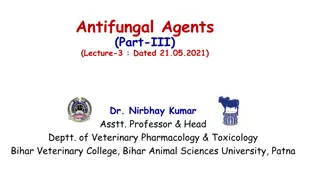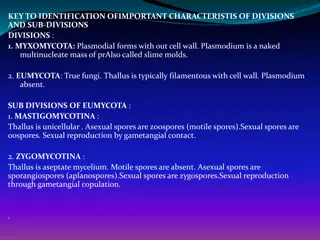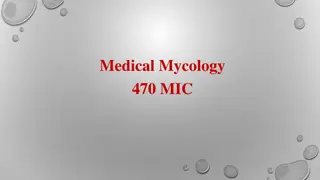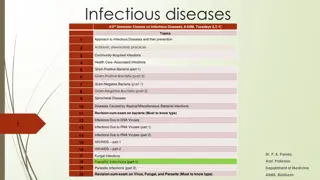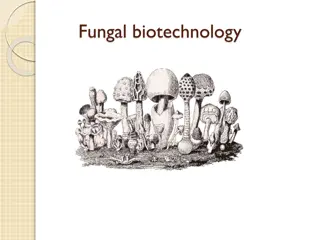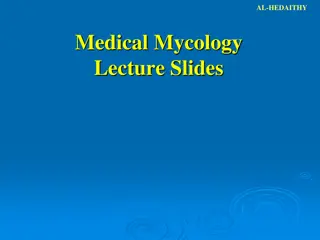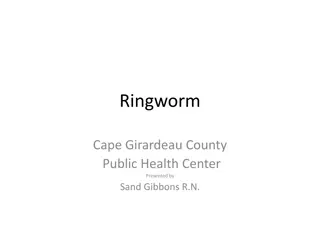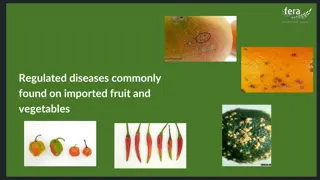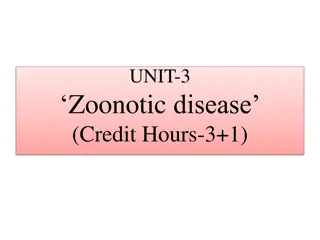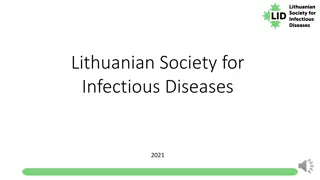Understanding Fungal and Protist Diseases: Impacts and Prevention
Fungi and protists play significant roles as pathogens, causing diseases in both humans and plants. Fungal diseases like athletes foot and protist diseases like malaria can have serious impacts on health. Control measures such as understanding symptoms, spread mechanisms, and prevention strategies are essential to combat these diseases effectively.
Download Presentation

Please find below an Image/Link to download the presentation.
The content on the website is provided AS IS for your information and personal use only. It may not be sold, licensed, or shared on other websites without obtaining consent from the author. Download presentation by click this link. If you encounter any issues during the download, it is possible that the publisher has removed the file from their server.
E N D
Presentation Transcript
Fungal & Protist Diseases Do now activity: 1. What are some of the symptoms of salmonella food poisoning? 2. How can we prevent the spread of gonorrhea? Keywords Pathogen Communicable Fungi Protist Malaria 3. What is fungi? Can you name any examples of fungal diseases?
Progress indicators GOOD PROGRESS: State one disease caused by fungi and one disease caused by a protist Describe the symptoms of diseases such as rose black spot and malaria OUTSTANDING PROGRESS: Explain how the spread of malaria can be controlled
Fungi and protists are less well known than bacteria and viruses but they are also important pathogens. Protists (single-celled organisms) are relatively rare pathogens but the diseases they cause are often serious and damaging. There are few fungal diseases that affect people, one relatively minor skin condition caused by fungi is athletes foot. Diseases caused by protists often involve a vector that transfers the protist to the host. In plants, fungal disease can be common and hugely devastating.
Stick the information on rose black spot and malaria in your books and complete the following tasks: https://www.youtube.com/watch?v=Jt5u1lX9yZI 1. Underline/highlight the key information on the description of the disease, the symptoms of the disease, how it spreads and how it is prevented. 3/4 2. Explain why roses affected by black spot produce smaller, fewer flowers than healthy plants. 5/6 3 marks 3. Describe how malaria is passed from one person to another 7 2 marks 4. Insecticide-treated mosquito nets help to prevent the spread of malaria in two ways. Explain how. 8+ 2 marks
Self-assessment: 2. Rose black spot causes black/purple spots to form on the leaves, eventually these leaves turn yellow and fall off the plant. This means there is less space for photosynthesis to occur (as less leaves) which means the rose plant will not make as much food as healthy plants. The lack of food means the plant will not be able to develop normally and therefore will produce smaller/less flowers. 3. Malaria is passed from one person to another by a mosquito carrying a protist, if the mosquito feeds on the blood of an individual the protist may be injected into the bloodstream. If it reaches the liver of the individual it can cause serious damage 4. The nets are impregnated with insecticide which will deter the mosquitoes from landing on/going near the nets. The nets will not allow mosquitoes through to bite humans, therefore preventing the spread of the protist.
https://www.youtube.com/watch?v=x74I-4BZnRo For travellers going from the UK to an area with malaria, doctors suggest the ABCD approach: Awareness Bite prevention Chemoprophylaxis (anti-malarial medicine) Diagnosis Task: Design a poster/pamphlet you might see at a doctors surgery which informs patients of the risks of going abroad to an area with malaria.
Plenary: Quick Quiz! 1. What are some of the symptoms of rose black spot? 2. How does the fungus that causes rose black spot spread? 3. State one treatment of the rose black spot disease 4. How does malaria spread? 5. How does the protist which causes malaria spread throughout the body? 6. Which parts of the body does the protist affect?
Self-assessment: 1. Purple or black spots which develop on the leaves. The leaves often turn yellow and fall off the plant. 2. The fungi is spread in the environment by the wind but can also be spread by water, as it drips from one plant to another. 3. Chemical fungicides can help to treat the disease 4. Malaria spreads via female mosquitoes which are known as a vector 5. The protist travels around the body in the bloodstream 6. The protist effects the red blood cells in the liver and causes recurrent bouts of fever and shaking, it can be fatal.
Rose black spot The female mosquito needs two meals of human blood before she can lay eggs, this is when the protist gets transferred from the mosquito and into the human blood. This is a fungal disease which affects rose leaves. The symptoms of the disease are purple or black spots which develop on the leaves, it is a nuisance in gardens and for commercial flower gardens. The leaves often turn yellow and fall off the plant quite early on. The protist then travels around the body in the bloodstream until it reaches the liver, it is here that damage to the red blood cells is done. Malaria causes recurrent bouts of fever and shaking, it can be fatal. As the leaves fall off the plants there is less space available for photosynthesis, this means that less food is made for the plant causing it to be weaker and not flower very well. If malaria is diagnosed quickly it can be treated using a combination of drugs, but this is not always available. The spread of malaria can be controlled in a number of ways: The spores of the fungi is spread in the environment by the wind. The spores can also be spread by water, as it drips from one plant to another. Using insecticide-impregnated insect nets to stop mosquitoes biting humans and passing on the protists Use insecticides to kill mosquitoes Gardeners can prevent the spread by removing and burning the affected leaves. Chemical fungicides can also help to treat the disease and prevent it spreading. Prevent vectors from breeding by removing standing water Malaria Travellers can take anti-malarial drugs to kill the parasites in the blood if they are bitten. This is a disease which is caused by a protist pathogen which lives and feeds on other organisms. The protist life cycle includes time spend within the human body and within the body of a female mosquito. Protists reproduce sexually in the mosquito and asexually within the human. The mosquito acts as a vector for the disease.









